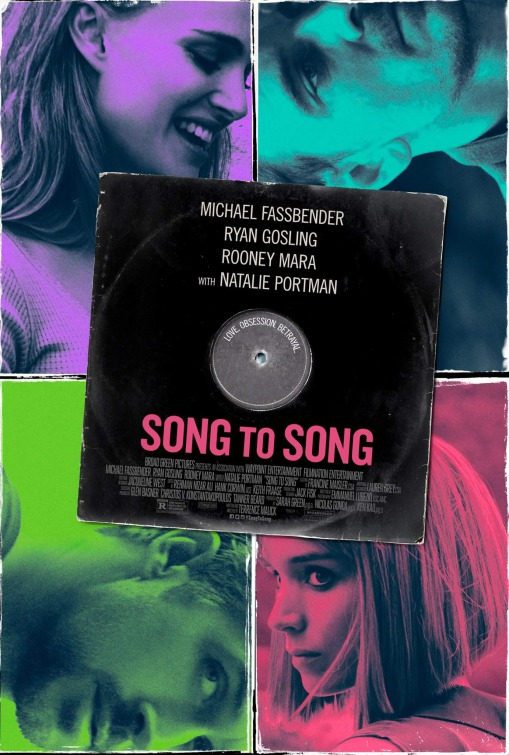SONG TO SONG Review

Director: Terrence Malick
Genre: Drama, Romance
Year: 2017
In response to Luther’s tacking the 95 theses to the doors of Wittenburg Cathedral, and the subsequent Protestant reformation, the Catholic Church, by the end of the 16th century, sought to promulgate their doctrine by way of patronage of the visual arts—specifically by way of the patronage of the Baroque art style. A Baroque artist, be it a painter, sculptor, or architect exaggerated ascending motion, life in movement, grandiose spirituality, and the exuberant soul to produce stupendous tension and scintillating drama in his respective medium. Although the movement passed away quietly in the early 18th century, its rebirth in the 21st emerges from the recent films of American auteur Terrence Malick: THE TREE OF LIFE, TO THE WONDER, KNIGHT OF CUPS, and now SONG TO SONG, a sublime cinematic collage, capturing love and betrayal, youth in its budding, unalloyed glory, aging and its painful toll, set upon the backdrop of the Austin, Texas music milieu.
Rooney Mara stars as Faye, a docile, at times tepid innocent whose romantic involvement with the affluent and devil-may-care Cook, played by the great Michael Fassbender, leads to a classical fall from grace: Cook’s deviant sexuality, his amoral and promiscuous ambition, poison Faye’s noble aspirations as a musician, rendering her a servant to his wickedness. BV, played by Ryan Gosling, enters the foray with his befriending of Cook, who abets BV with a potential career ignition—financial backer, a guide to the underworld that is Austin high society. To complicate matters, BV falls in love with Faye; like the stage upon which musicians will perform at the Austin City Limits Festival, Faye’s, Cook’s, and BV’s fates are set, melding into one imminent love-triangle, whereby Malick derives the film’s central conflict. Natalie Portman’s character, Rhonda, a benevolent, but down-on-her-luck Christian waitress, fans further the flames of love when she romantically mingles with Cook, despite her being his antithesis.
The performances of all foregoing actors and actresses bring to life their respective idiolects, nuanced gestures, their physical prowess on set; Malick’s minimalist dialogue and free-flowing blocking forces them to do so—and they thrive admirably. Cate Blanchett, who plays Amanda, a graceful socialite, lover of BV’s, subtly permeates the film with her beauty and sang-froid. Also featured: Val Kilmer, Bérénice Marlohe, Lykke Li, and Patti Smith (Smith’s mentorship with Faye becomes quite endearing).

Suave but brooding Caucasians . . . nothing new for Malick
Cinematographer Emmanuel Lubezki returns for the third film of Malick’s contemporary “trilogy” (TO THE WONDER and KNIGHT OF CUPS being the other two). Lubezki’s trademark wide-angle aesthetic captures well Malick’s directorial style—free-flow blocking, improvisation, disregard for continuity; wide frames are the best canvases for movement, and a roving camera becomes an additional dance partner in a frolic for youth. Although at times the wide-angle distancing can hinder characters’ emotional expressivity, the gorgeous natural lighting and the camera movement’s own expressivity translate into emotions perhaps lost to the viewer during sequences of Lubezkian, Malickian cinema. Gosling, in particular, thrives in such takes—his charisma could be seen for miles—and Fassbender, to boot, radiates salacious presence and devilish insanity, both of which conducive to wide-angles. Technically speaking, the film bears striking semblance to Malick’s previous two films, and likewise with tonality. Malick’s collage-esque pacing—his weaving scenes of exceptional love, loneliness, exceeding despair, back to love with the thread of voiceover narration, location sound, interspersed shots of Austin, nature, paintings, archive footage at one point—can be cumbersome: this is not anything boldly original for Malick or his patronage. But for audiences who’ve yet to experience cinema à la Terry, the film has the potential to change atoms.
SONG TO SONG constructs itself steadfastly through the two-hour and nine-minute runtime. Malick underpins a Cathedral of effulgence—in the vein of Baroque art—a testament to the persistence and power of love—romantic, platonic, filial—with character-driven vignettes of tension, foreplay, charm, and malice. The backlots of music festivals, the suburban outskirts and the downtown apartments, the swank of Austin, provide Malick with the foundation for his mediating; Austin is also a city teeming with culture, an oasis in the desert that is Texas: a locale whose population frets their lack of record deals, not their lack of crop yields. Whether it’s BV and Faye sauntering below Austin’s freeways in a morning mist, or Cook and Rhonda engaging in mutual seduction, or BV visiting his younger brother and his senile father, the direction exudes reverence and freewheeling passion—but passion and youth with a price. As characters ebb and flow within one another’s lives, sequences become all the more heart-warming, or, all the more heart-wrenching: as the mere spectator, I become fully aware that their days in Austin are, as Dickens says, “the best of times….the worst of times”: youth and maturation in its essence. Malick warns us that paradises will be lost in maturation, through lust or ambition or greed, but novel paradises, redemptive ones at that, can always be reclaimed through sacrifice, through love.

Hell yeah! Really ripping that fretboard, Rooney!
Our film section editor Sergio Zaciu aptly placed KNIGHT OF CUPS in his “Fine Wines of 2016,” describing Malick’s work as a piece which will grow on the viewer in due time; with SONG TO SONG, however, I will go further by deeming it an already finely aged wine (the film’s production began in September of 2012), a cabernet sauvignon having ascended to its exalted peak. Malick has concocted a film for the decade, a wine, although not entirely quaffable, worthy of savor and submission; he has constructed the Cathedral to stand tall amidst the giants in Marvel Studios, summer blockbusters, reboots, etc. Sip it, sit in a pew, behold its grandeur. Behold youth and love and life in motion—strong motion, that is.
Verdict: Recommend



